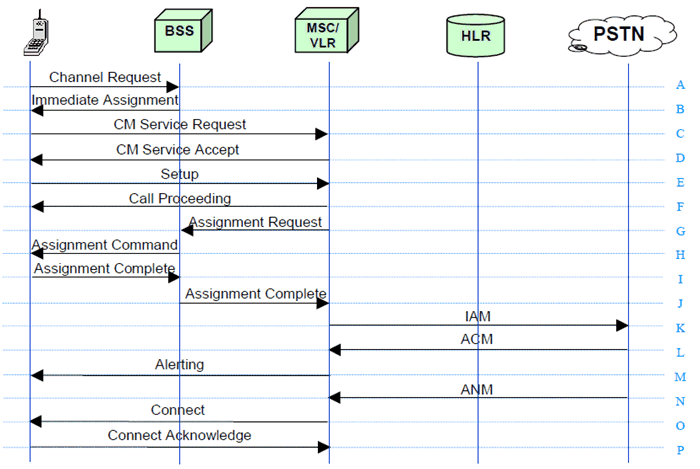Content for TR 22.952 Word version: 18.0.1
0…
4…
4.8…
5
5.1
5.2
5.3
5.4
5.5
5.6
5.7
5.8
5.9
5.10
5.11
5.12
5.13
6…
A…
B
B.1
B.2
B.3
B.4
B.5
B.6
B.7
B.8
B.9
C
D…
5.1 Priority service call origination - radio resources available, call not queued p. 17
This clause illustrates a Mobile Originated (MO) Priority Service call establishment with early radio traffic channel assignment for a Service User. In this scenario, radio traffic channels are available when the Priority Service call is attempted. With the early assignment option, the PLMN allocates a traffic channel to the MS before the PLMN initiates call setup to the PSTN.

Step 1.
Immediate Assignment Procedure (Establish a Radio Resource (RR) connection between the MS and the BSS)
A.
Step 2.
The Service user dials the Priority Service prefix (e.g., *272) + Destination Number. The MS sends a Channel Request message to the BSS on the Random Access Channel (RACH) channel. Having sent M + 1 Channel Request messages, the MS starts RR timer T3126. M is the value of the parameter "max retrans" broadcast on the Broadcast Control Channel (BCCH).
B.
The BSS allocates a dedicated channel to the MS by sending an Immediate Assignment message on the same Common Control Channel (CCCH) timeslot on which it has received the Channel Request. The BSS starts RR timer T3101.
Service Request and Contention Resolution Procedure (Establish the main signalling link between the MS and the BSS)
C.
Step 3.
The MS stops RR timer T3126 on receipt of an Immediate Assignment message corresponding to one of its three last Channel Request messages. The MS stops sending Channel Request messages, sets the channel mode to signalling only, and activates the assigned channels. The MS sends a CM Service Request message to the MSC/VLR. The MS starts Mobility Management (MM) Timer T3230 and Call Control (CC) Timer T303.
D.
- The initial service request CM Service Request message is sent by the MS to the BSS piggybacked in a Layer 2 (L2) Set Asynchronous Balance Mode (SABM) frame to establish the main signalling link. The BSS stops RR timer T3101 when the main signalling link is established. Contention resolution is achieved by the BSS by including the same CM Service Request message, received in the L2 SABM frame, in a L2 Unnumbered Acknowledgement (UA) frame.
- The initial Layer 3 (L3) CM Service Request message is passed to the MSC/VLR by the BSS using a Complete Layer 3 Information message.
If the MSC/VLR omits authentication and ciphering, it sends a CM Service Accept message to the MS. Otherwise; the MSC/VLR starts the authentication procedure. (Authentication procedures are not illustrated in the call flow).
Mobile Originating Call Establishment Procedure
E.
Step 4.
The MS sends the Setup message after sending the Ciphering Mode Complete message to the BSS or after receiving the CM Service Accept message from the MSC/VLR. The Setup message includes the called address (e.g., *SC + Destination Number).
F.
The MSC/VLR detects the dialled Priority Service prefix (e.g., *SC) in the dialled digit string and queries the user's profile to verify that the user is subscribed to Priority Service and to obtain the Service User's priority level. The MSC/VLR returns a Call Proceeding message towards the MS to indicate a positive outcome for the call setup procedure. On receipt of the Call Proceeding message, the MS stops CC timer T303 and starts CC timer T310.
Traffic Channel Assignment (Early Assignment)
G.
Step 5.
The MSC/VLR sends an Assignment Request message to the BSS, which includes the call priority level and the queuing allowed indicator.
H.
As an idle radio traffic channel is available, the BSS initiates the channel assignment procedure by sending an Assignment Command message to the MS on the main signalling link and starts BSS Management Application Part (BSSMAP) timer T10 and RR timer T3107.
I.
On receipt of the Assignment Command message, the MS initiates the activation of the channels, their connection, and the establishment of the main signalling links. After the main signalling link is successfully established, the MS returns an Assignment Complete message, specifying cause "normal event", to the network on the main Dedicated Control Channel (DCCH)
J.
On receipt of the Assignment Complete message, the BSS releases the previously allocated resources, stops RR timer T3107, and stops BSSMAP timer T10. On successful assignment of the required channels, the BSS returns an Assignment Complete message to the MSC/VLR.
Alerting Procedure
K.
Step 6.
On receipt of the Assignment Complete message, the MSC/VLR sends an ISDN User Part (ISUP) Initial Address Message (IAM) to the succeeding switch and starts ISUP IAM timer T7. The ISUP IAM message includes the Calling Party's Category parameter set to the International Emergency Preference Scheme (IEPS) call marking for preferential call set up and the Precedence parameter set based on the Calling Party's priority level.
L.
The destination returns an ISUP Address Complete Message (ACM).
M.
On receipt of the ISUP ACM message, the MSC/VLR stops ISUP timer T7 and sends an Alerting message to the calling MS. On receipt of the Alerting message, the MS stops timer CC T310.
Call Connect Procedures
N.
The destination returns an ISUP ANswer Message (ANM).
O.
On receipt of the ISUP ANM message, the MSC/VLR sends a Connect message to the calling MS, and starts CC timer T313.
P.
On receipt of a Connect message, the MS attaches the user connection, returns a Connect Acknowledge message to the MSC/VLR, and stops any locally generated alerting indication (if applied). Upon receipt of a Connect Acknowledge message, the MSC/VLR stops all CC timers.